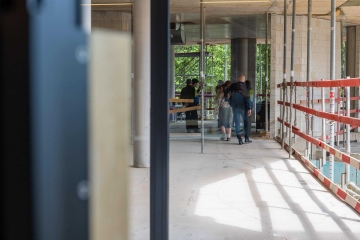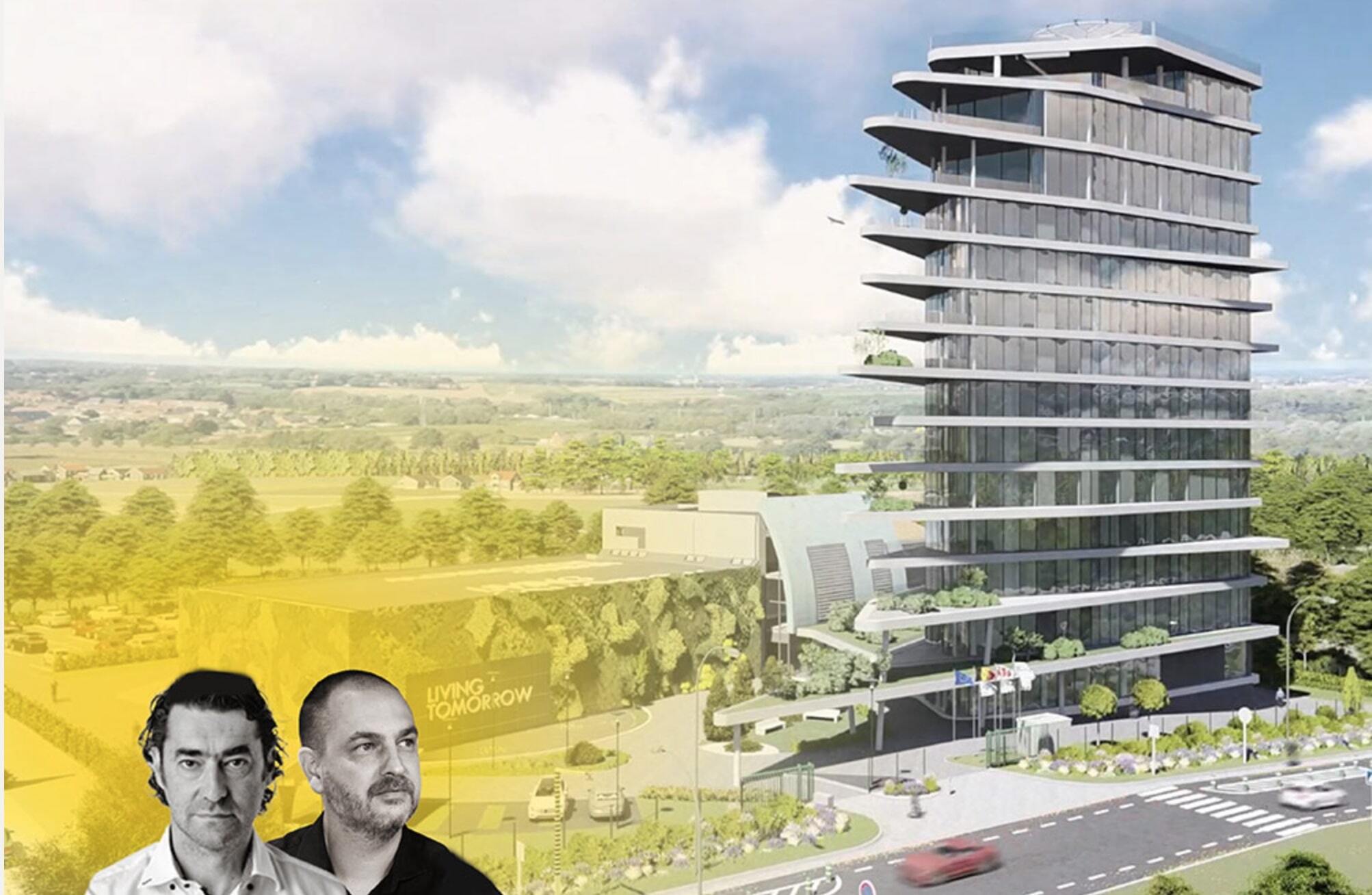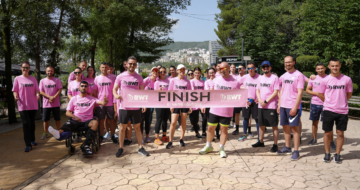To help the construction industry grow we must take a step back

Building the home of the future also means looking into the future of the construction industry. Frederik Vaes (UAU Collectiv) and Bart Thijs, two architects behind our new ‘Living Tomorrow’ campus, see several important developments. “The soaring prices of energy and building materials and the importance of sustainability are forcing us to look beyond the latest gadgets and attractive design”, they say.
Building the home of the future also means looking into the future of the construction industry. Frederik Vaes (UAU Collectiv) and Bart Thijs, two architects behind our new ‘Living Tomorrow’ campus, see several important developments. “The soaring prices of energy and building materials and the importance of sustainability are forcing us to look beyond the latest gadgets and attractive design”, they say.
Building the home of the future also means looking into the future of the construction industry. Frederik Vaes (UAU Collectiv) and Bart Thijs, two architects behind our new ‘Living Tomorrow’ campus, see several important developments. “The soaring prices of energy and building materials and the importance of sustainability are forcing us to look beyond the latest gadgets and attractive design”, they say.
Executing architect Frederik Vaes: “We are taking things to the next level beyond the ‘home of the future’. We are working on a veritable innovation campus in Vilvoorde, which will include a hotel and a restaurant. But the most important thing is actually the road that leads there”.
Frederik Vaes: “Contrary to Living Tomorrow’s previous project in our country we don’t want to go too high-tech with this one. More even, we want to get back to basics. This stems from the philosophy that we have to reuse more and adopt a more sustainable approach. New gadgets and a futuristic design are great but they have nothing to do with sustainability, and precisely that is the future”.
Frederik Vaes: “Correct. In the nineties and noughties design was really hot. The leading architects were genuine rock stars at the time. Today this is no longer the case because everyone is starting to realise that all design is temporary. Design is about making something that is nice and compatible with the spirit of the times. But now we have to look beyond that Zeitgeist because we need to get away from the throw-away culture. In the future we’ll have to be able to make adjustments to suit the needs of the people or organisations that occupy a building. These needs change over time and your building must evolve right alongside them.
Bart Thijs, architect: “I agree wholeheartedly. This also applies to urban development. We have to densify our city centres to make them more liveable and that is also what we want to achieve with this project. The initial plan consisted of a main building with several other, smaller structures around it but we abandoned that plan and initiated discussions with the city council. They gave us the green light to build up to a height of fifty metres and that is why we are now constructing a single, multifunctional building. To me, that is also a future-oriented project”.
Bart Thijs: “One section of the building will house a Digital Experience Centre of approximately five hundred square metres within the innovation campus, where partners can test products that are still in the pipeline. This way you can easily look ahead five to ten years but in truth the entire building process is extremely high-end”.

Frederik Vaes: “In part. We want to be more than just a showroom because that would mean we’re already lagging behind. You have to create a kind of canvas upon which to experiment, a meeting place for partners where they may even gain novel insights they wouldn’t get anywhere else”.
New gadgets and a futuristic design are great but they have nothing to do with sustainability, and precisely that is the future.
Bart Thijs: “We need more sustainability and flexibility everywhere. You need to be able to reuse buildings. So in that sense it’s not so much about being a pioneer in everything you do but rather about reflecting on which combinations will prove sustainable in the future. This is not just because sustainability is exceptionally topical today but also because materials prices have skyrocketed due to Covid and the war in Ukraine. Although prices will probably stagnate I don’t see them going down anytime soon and this gives rise to new business models. Just think of buildings with a façade that can be leased to give it a second life, for instance. Projects of this nature lead to new insights”.
Frederik Vaes: “In my opinion it’s also a philosophical discussion. I think we need to reorient and decide what it is that we want, because we are spoilt rotten. If you want to build a townhouse in our country you have to take into account it can’t be hotter than 25 degrees inside for more than ten days a year. As if the building alone is responsible for the inside temperature. You could see it from the opposite perspective: if it’s too hot, you can start an hour earlier and take a one-hour break at the hottest time of the day”.
Frederik Vaes: “We’ve gone overboard. There are too many rules and conditions and it’s all becoming too expensive”.
Frederik Vaes: “Of course, but sometimes you have to take a few steps back in order to keep evolving”.
Bart Thijs: “I don’t think so. I think everyone is looking into how best to evolve, quite simply because they still want to be around in twenty years, not just tomorrow and the day after. Look at how fast building materials have evolved in the last decade. You simply have to keep evolving for your business to survive.
Living Tomorrow is an interesting project for us to exchange ideas with the other partners, and to discuss and analyse new concepts.
Frederik Vaes: “There is no other way but we also face an additional problem. There is a major housing shortage and the government isn’t doing enough. The Vlaamse Huisvestingsmaatschappij (Flemish Social Housing Company) never reaches its targets and so everyone is wholly dependent on the private market. Back in the day the private market often consisted of small independents, who purchased a block of flats consisting of maybe four units that they would rent out for their pension. Today there are hardly any left. Developers are becoming larger and larger and they are cornering the entire market. The question is to what extent they are prepared to go along with this shift”.
Frederik Vaes: “Because it is important to involve the household names in this project. Naturally we also have to consider alternative materials and partners but in order to bring about change on a wide scale you need partners like Recticel. This way, the different partners help shape the future through workshops and vision groups”.
Bart Thijs: “Recticel reflects on the building envelope: what to do with the roofs, floors and walls? On the one hand we have to comply with legal obligations but we also want to go further. For instance, perhaps insulation can be used as a building material. Those are interesting lines of reasoning. That is why we like to have Recticel at the table”.
Peggy Matthys, Head of Marketing Recticel: "Living Tomorrow is an interesting project for us to exchange ideas with the other partners, and to discuss and analyse new concepts. The innovation campus of Living Tomorrow can act as a testing ground from where new products can develop and where these innovations can be shared with and showcased to architects, contractors and politicians.The focus on ecodesign and modularity are central to all of these evolutions. Recticel wants to make insulation multifunctional and make as many materials as possible reusable. We view the collaboration with Living Tomorrow as the extension of our innovation strategy. Together with the technology partners, architect and contractor of this project, we aim to develop a number of sustainable insulation concepts and business models that result in a reduction of CO2 emissions or increased productivity at the construction site."
Latest insights & stories

A Global Movement: The World Unites in a Pink Pledge for Clean and Sustainable Water
5,000 participants. 32 countries. €30,000 funds raised. And that's just the beginning.
Picture this: One step that sends ripples across the globe, transforming lives and creating waves of change. You might wonder, how can such a simple action for most of us have such a profound impact?

Sustainability and circularity in construction
Join us in transforming the future of construction, creating buildings that not only stand the test of time but also contribute to a healthier planet!

RainTunes: Shower scenarios for the soul
Light, hearing, smell, and touch: Together with experts, we have developed sensuous scenarios that turn showering into an individual experience. Whether you want to prepare for the day ahead or relax after working out. Whether you want to refresh after a day’s work or unwind at the end of the evening: RainTunes surprises with multisensory experiences.*
*Currently available only in Germany and Austria.